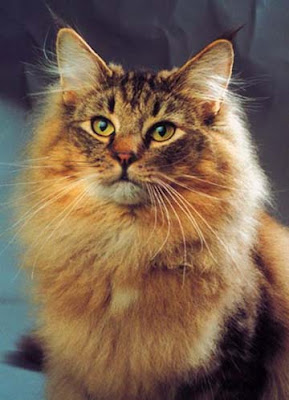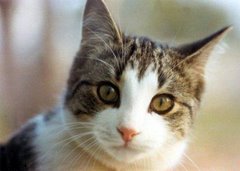The Occicat was the accidental result of an experiement in 1964 to interbreed American Short hairs, Abyssinians and Siaimese cats to achieve the rare Abyssinian pointed Siaimese cat. After this experiment the goal was indeed achieved but there in the litter appeared this sweet spotted kittens that was later named Ocicat after the a wild cat species called the Ocelot by the daughter of the breed's developer Virginia Daly a noted CFA breeder.
"Purple Rain"
The ivory kitten with golden spots was the first Ocicat to be born and it was named Tonga which was later neutered and sold as a pet. The cat then came into the spot light with the aide of a famous news paper in Detroit that publicized about an attractive spotted cat which was actually Tonga, and then a geneticist Dr. Clyde Keeler who expressed a deep desire to have a cat like Tonga because of its resemblance to the endangered Ocelot.
"Loepardus pardalis"
Ocelot (Leopardus pardalis) is a wild cat native to south america and texas, they are an arboreal species of cat that prowl the darkness of the nighttime rain forests. These very territorial cats have been hunted and killed for their beautifully patterened coat which is studded with large and attractive rosettes and spots.
"Hanuman"
breeding was then repeated to achieve the births of more Ocicats, and then other breeders started to follow the methods used by Virginia and eventually helping in the promotion of the cats as a new breed and established a broad genetic pool in the process.
"Jeep"
The Ocicat was recognized for CFA registration in 1966, but it took another twenty years to develop the breed and gain enough support from other catteries and breeders to achieve provisional status. The Ocicat was advanced to championship status on May 1987 to the delight of Virginia and her daughter who first developed and named the breed.
"Wedjat"
There has been tremendous controversy about the genetics of the spotted pattern. In the past all patterned cats were believed to display one of the three tabby patterns: ticked (Aby), mackerel (tiger striped), or classic (blotched or bull's eye). The spotted pattern of the Ocicat is said to be different from other spotted breeds or patterns. Some cat fanciers and experts say this is due to a totally different gene from the regular tabbies but there is no conclusive evidence to prove it. Some suggest that it was selective breeding that eventually gave rise to the random arrangement of genes that is now expressed on the Ocicat.
 "ZIN"
"ZIN"Because of the pure domestic blood of the Ocicat it's temperment is exquisite, often described by its owners as dog like, because of its trainability, confident nature and its athleticism, this cat is indeed for the out going kind of person who doesnt want a bashful kitty in his house.
 "TUT"
"TUT"
come in many colors and at least all those colors associated with the three foundation breeds: tawny, chocolate, cinnamon, blue, lavender, fawn, silver, chocolate silver, cinnamon silver, blue silver, lavender silver, and fawn silver and all of them must be studded spots to be able to fit the standards.

If you want to learn more about this breed and would like to purchase one please click on these sites:
http://www.ocicats.com/index.html?_ret_=return
http://ocigatos.homestead.com/

For the breed's standards in TICA please refer to this link:
http://www.ticaeo.com/Content/Publications/Pages/OC.pdf
For the standard in CFA please click on this link:
http://www.cfainc.org/breeds/standards/ocicat.html"All photos seen here are not my own and in no way am I claiming them to be my own. Some have the knowledge of the owners of me showcasing their cats Photos.
These photos are here to give adequate and vivid representations of cat breeds and conditions and are in no means for profit."


























































